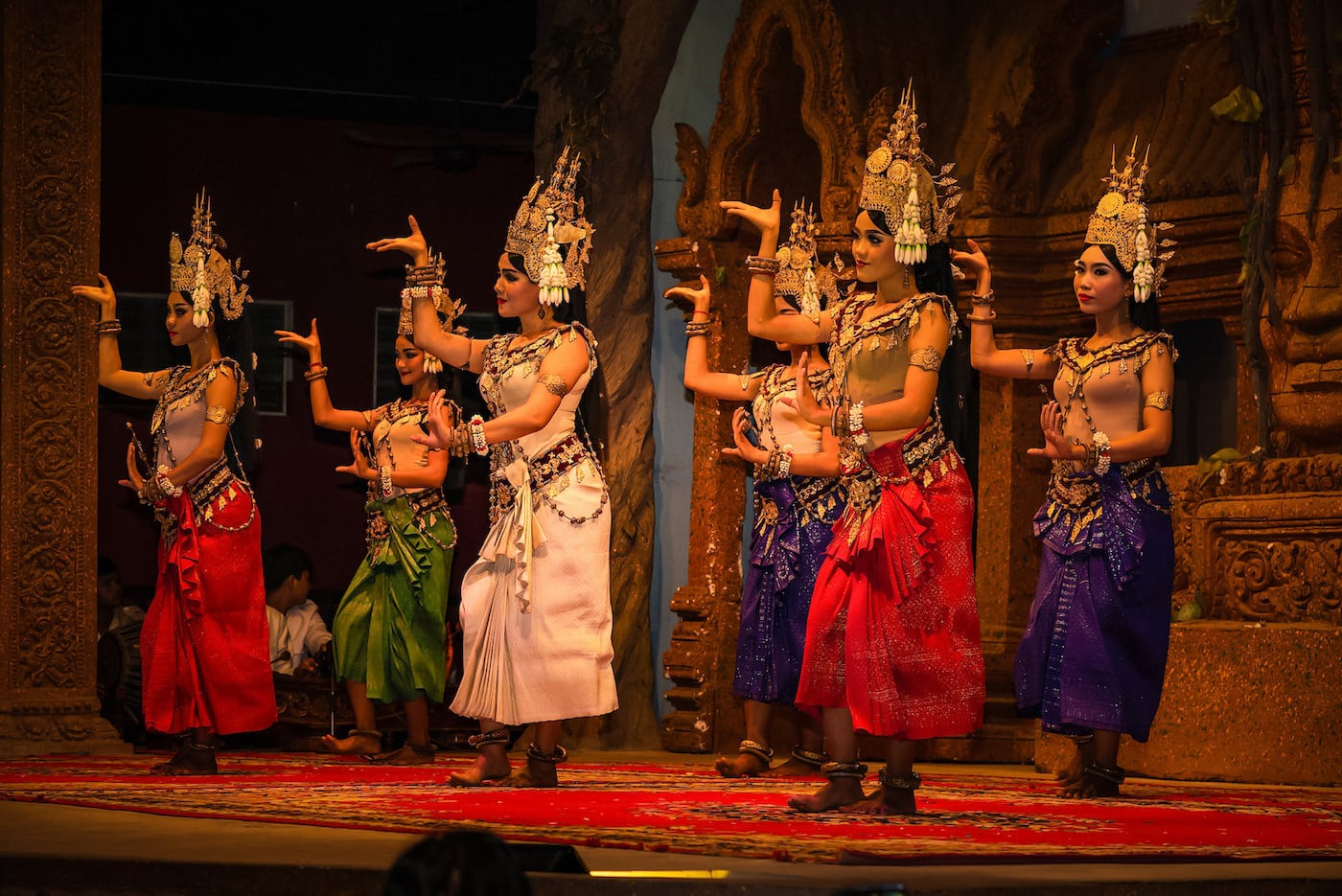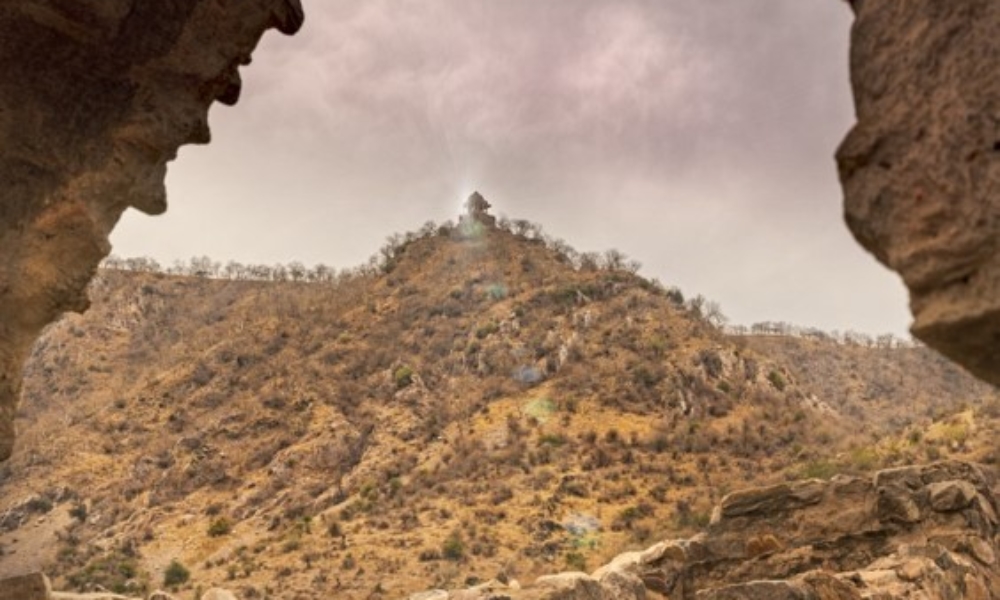The Apsara legend
Mera, queen of the Apsaras (heavenly Nymphs) looked down pensively upon the green land of Kamboj on earth below. She felt jaded and a little desperate, unable to find a deserving husband amongst the Gandharvas (heavenly musicians) who the Apsaras traditionally wed! Down below, she spotted the Sage-King Kambu, whose valour and kindness had quite captivated her heart. She made up her mind to forsake her life of heavenly luxury, and even immortality, to be with her chosen one.
So, she descended to Kamboj (modern day Cambodia) and married King Kambu. Their union gave rise to the Khmer people, the name being a combination of Kambu and Mera. Today the Khmers are the dominant race in Cambodia.
The Khmers began their journey to glory in the 9th century A.D. when King Jayavarman II legitimized his claim to the throne in a ceremony on Mount Kulen. The golden period of the Khmer Empire followed, ruled by successive kings who adopted the Hindu Dev Raja cult in which the king was a living embodiment of the supreme Hindu God Shiva. The Hindu influence continued for about four centuries, to be replaced thereafter by Theravada Buddhism. Today about 95% of the Cambodians are Buddhist and hardly anyone in the land practices Hinduism or the worship of Shiva.
The Cambodian Dance Tradition
Since the king was considered a living God by the Khmers, dances for royal ceremonies and for special occasions were performed by beauteous, graceful ladies in the Apsara tradition in what became a royal Cambodian custom. After the Cambodian royalty became Buddhists, while royal support for traditional Cambodian ballet continued, the Apsara dance was discarded.
Under French rule, Cambodian ballet received world recognition and was officially known as the Royal Cambodian Ballet Troupe, who performed traditional Cambodian and Thai dances using stylized gestures and movements based on themes from ancient Hindu texts such as the Ramayanas called Reamkar (Glory of Rama) in Cambodian. The Cambodians adapted Hindu ideas to Buddhist themes very successfully and artistically. But their ballet did not have an Apsara dance.
The Cambodian Ballet
Except for a brief interruption during the bloody Pol Pot regime, Cambodian ballet has centuries of continuous tradition behind it. In the 1940’s, Sisowath queen of Cambodia, witnessed a ballet by school children based on the Apsara legends carved on the walls of the ancient temples of Angkor Wat. She was charmed and thus, the Apsara dance was again officially added to the repertoire of the royal Cambodian ballet.
In 1967, the queen’s granddaughter Princess Norodom Buppha Devi, daughter of King Norodom Sihanouk, performed the Apsara ballet in public. Buppha Devi combined two legends to create her ballet. The first part was from ancient Hindu texts that described the churning of the primordial ocean when the gods and demons searched for the elixir of Immortality called “Amrit”. In the process, the spirits of water and clouds were released as heavenly nymphs or Apsaras. The Apsaras ascended to heaven to become dancers in the court of the Gods. The second part of the ballet was based on the Cambodian love story of king Kambu and the Apsara queen Mera. The ballet caught public imagination both in Cambodia and abroad. Princess Buppha Devi, who had started training for ballet dancing at the tender age of five, was an accomplished ballerina by then. She led the royal Cambodian dance troupe in many performances all over the world.
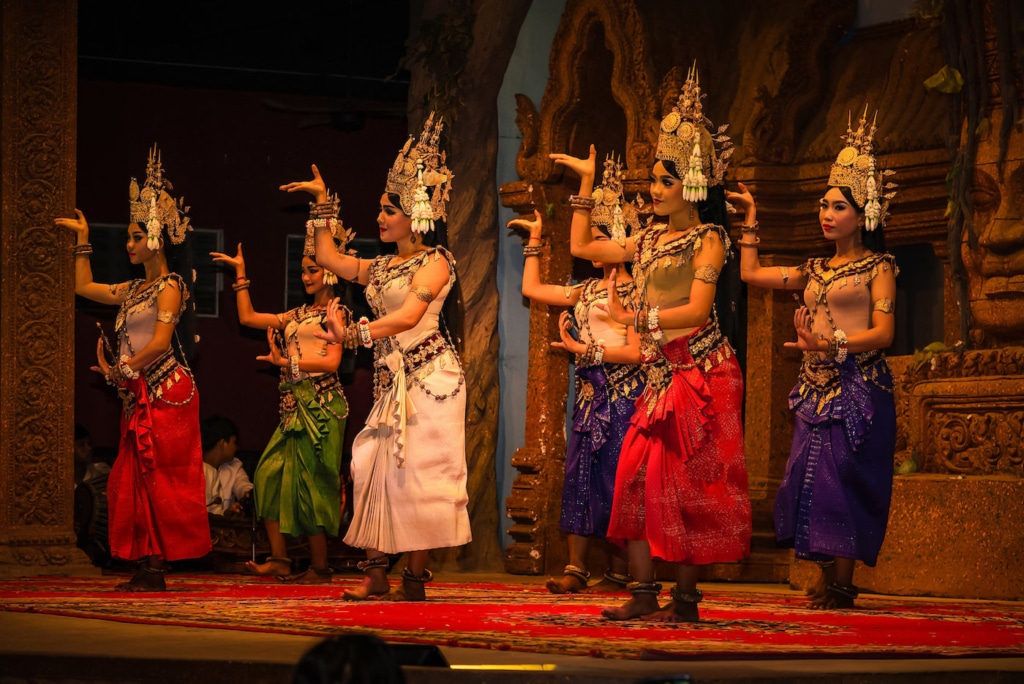
With spread of tourism, the world at large became familiar with Cambodian ballet and referred to the entire performance as the Apsara dance. Like all forms of Cambodian ballet, the Apsara dance is characterized by elaborate costumes, graceful hand movements and traditional Cambodian music. Unlike many Indian dance forms such as Bharat Natyam, the face remains calm, serene and no expressions are used.
Other Folk Dances of Cambodia
Although the Apsara dance is perhaps more closely associated by the world with Cambodian tradition and culture, there are other dances practiced, such as folk dances telling popular tales or celebrating a good harvest. Some folk dances represent the culture of minority tribes such as the Upland Khmers, the Lao and the Cham people.
To regale the tourists, Cambodians arrange dance shows that mix the Apsara dance with other folk dances to provide an hour long entertainment. Many hotels include such shows along with dinner, to provide guests with a well rounded experience of Cambodian food and culture.
The folk dances were created in the 20th century. Compared to the Apsara dance, they are fast-paced and much play acting is added. The movements and gestures are not so stylized. Folk dancers wear clothes of the people they are portraying such as Chams, hill tribes, farmers, and peasants. Some dances are about love or folktales. The music of folk dances is played by an orchestra using mainly string and percussion instruments of traditional Cambodian design.
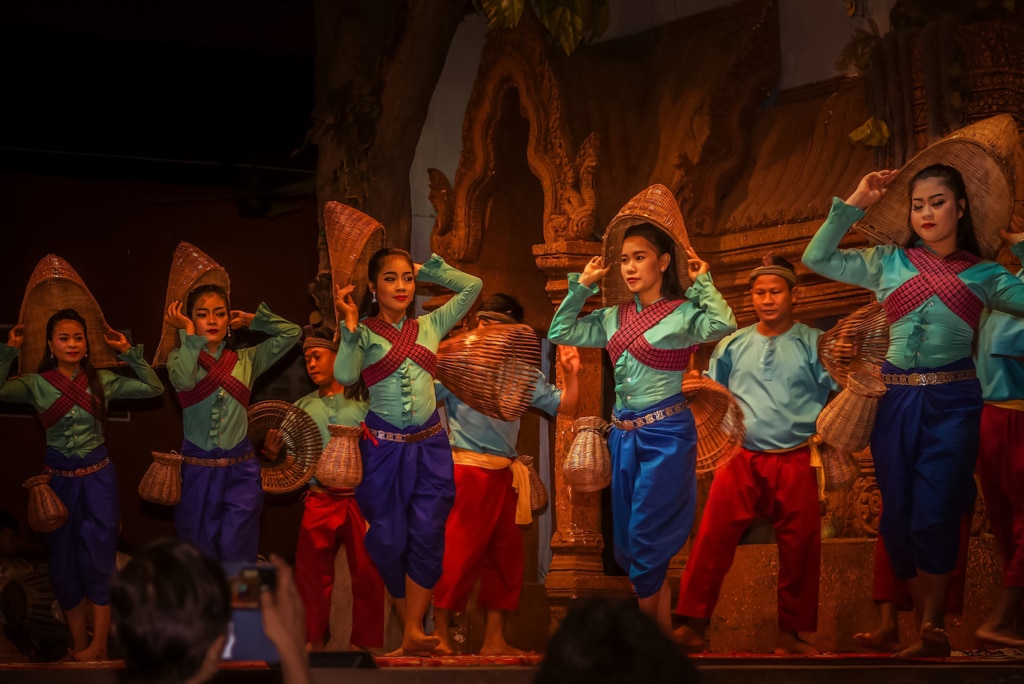
Khmer Fishing Dance (Robam Nesat) – The charming courting scene and the playful teasing among the young men and women make this dance very popular. Young men come dancing down to the river on one side and women from the other. They show how happy and excited they are to meet. As they fish, they flirt with each other. The boys playfully snatch the girl’s fishing baskets. The dancers leave one by one and only one couple is left behind who fall in love. At the end of the dance, the group returns to tease and congratulate them.
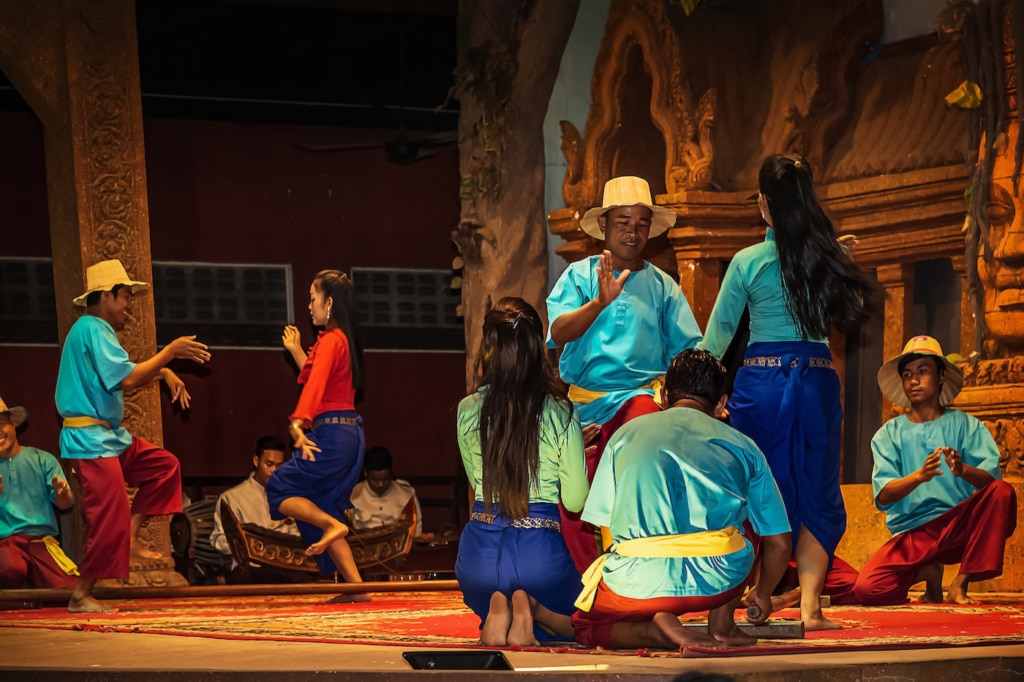
The Bamboo pole dance (Robam Kom Araek) – The dancers jump in and out between rapidly clapping bamboo poles. Much dexterity and timing is essential. It is believed that King Norodom (1834-1904) picked up this dance when he was traveling in the Philippines.
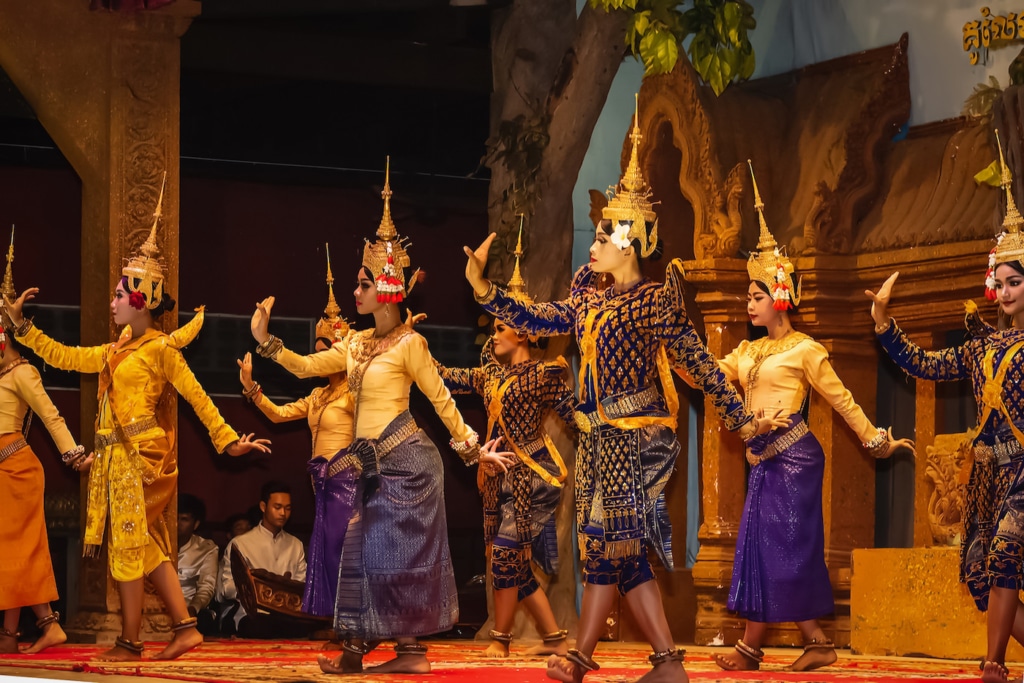
| The Peacock of Pailin Dance – The Peacock of Pailin Dance is a courting scene between a peacock and a peahen and it is said that this dance brings happiness and prosperity to the villagers. Pailin province is the only place in Cambodia where peacocks are found. It is a very colorful dance. The performers dress in traditional costumes that have been designed to look like both the peacock and the peahen. Are the children of Kambu and Mera half Apsara and half human then? Perhaps not! However, all of us who have the opportunity see the Cambodian dancers perform, will agree that they are truly beautiful and very graceful Apsaras who will not shame any court of the Gods! |

